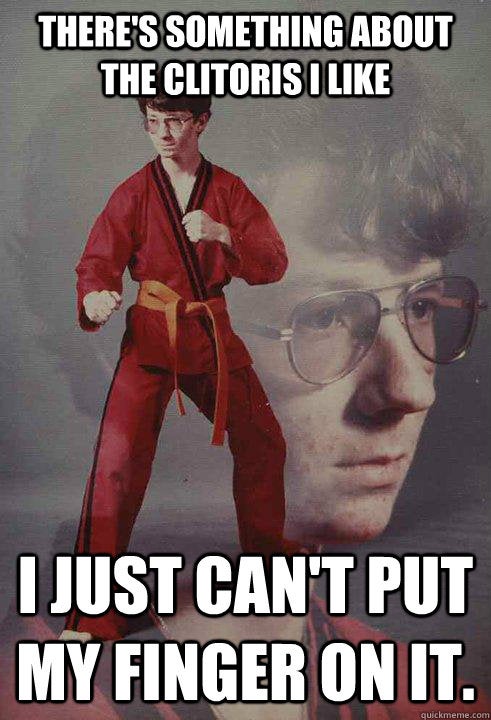I never thought I’d say this out loud, but I’ve been thinking about the film Dinner for Schmucks since it came out in 2012. Not because of its star-studded cast or the “nourishing” quality of its comedy, but because there’s a scene in it that perfectly epitomizes the crushing feeling of someone not being able to find my clit.
In it, Zach Galafinakis chastises Steve Carell’s character Barry about the reason why his wife left him as they’re sitting around the dinner table. Barry, ostensibly the schmuck here, bashfully offers the following explanation: “Because I… lost her clitoris,” he whimpers. “She got mad because I couldn’t find it. I said, ‘It’s probably in your purse.’ Nine times out of ten, when she loses something, that’s where it ends up.”
Obviously, this scene is a stereotyped, Hollywood-flavored representation of men’s infamous inability to “find” the clitoris, but to anyone who has one, it’s actually not too far from the truth. We’ve all had our urethras, labias, buttholes and thighs mistaken for our clits at some point in our sexual lives, just as we’ve all tried to explain to our partners where and how to touch it, only to have them continue to mash it around like it was the world’s smallest turntable at the mercy of the world’s worst DJ.
This shared experience is well-represented with data. In fact, according to a 2013 study of 236 participants, 44 percent of men can’t “find” the clit at all, a statistic I’m sure exactly zero women need to be reminded of:


It’s not exclusively a cis guy problem, though — 29 percent of college-aged women can’t hit the bullseye on an anatomical diagram, either. According to the study’s author, sexuality educator and gynecological nurse practitioner Sheri Winston, that’s probably because many American women are still recovering from the complete moratorium on accurate sex information the first half of the 20th century wrought. “Fifty years ago, the repressive culture around female sexuality meant many women didn’t even know they had a clit,” she explains. “How were men supposed to ‘find’ something hardly anyone was aware was there?” (Especially after they checked her purse?)
To say this is a problem is a bit of an understatement. Women only orgasm at about a third of the rate of men during heterosexual sex, and roughly 75 percent of us need clitoral stimulation to cum. Once you know a little about the clit, it’s easy to see why — with more than 8,000 nerve endings packed into its head, the clitoris is two to three times more well-innervated than the penis and is the only organ in the human body whose sole purpose is pleasure. For this reason, it’s been revered and worshipped in many cultures throughout history — from Ancient Egypt and India to the modern tribes of East Africa.
However, it’s also been erased, mutilated and pathologized in many others, a sordid history that goes a long way in explaining how it’s possible that we’ve put a man on the moon, but can’t seem to find, or adequately caress, an organ that roughly half the population is packing.
How did we get like this? Why does it seem like some men can’t find the clit any more than they can Bigfoot, and what do we need to move past that tired cliché?
To find out, let’s take a look back in time.
2001: A Clit Odyssey
While today’s internet is filled with memes and jokes about how men “can’t find the clit,” there aren’t many historical accounts that describe this phenomenon in the same way we understand it now. That’s because for the past few millennia, the people keeping records have predominantly been men in positions of power — doctors, clergy, philosophers, government officials. To admit they couldn’t find a body part — and therefore, satisfy a woman — would have been to admit failure, which is not, understandably, something many of them were interested in doing. Rather, as I’m about to show you, they were more interested in staking claim on the clit as their own intellectual property, or medicalizing it into oblivion. Keeping records about clitoral mishaps also would have meant that they valued female pleasure or believed there was anything to find at all, neither of which was the case for most of recent Western history.
So while there are plenty of historical accounts of men believing the clit was confusing, insignificant or a definitive sign of Satan, we don’t really know for sure whether everyday men were looking for it in the same way they are today, nor is it clear what women thought of the whole thing. What we do know, however, is that, for most of recent Western history, the clit was a well-known entity that people tried to ignore. In fact, historically speaking, locating it was never really the problem; men ”found” it in medical case studies and dissections all the time. The problem was what they did with it when they got there.

From smearing it with carbolic acid to writing it in and out of medical textbooks every other century, men have continuously discovered, forgotten about and then reacquainted themselves with the clitoris, a rocky past that’s culminated in some contemporary confusion about whether it’s nestled right there in the silky folds of the labia, or somewhere down the block drinking sangria and playing Cee-lo with its cousins.
We can go all the way back to 460 B.C. to see evidence of this clitorial confusion. That was year Hippocrates, the “Father of Medicine,” began to refer to female genitalia as “the shameful parts.” Though he encouraged a mixture of clitorial and vaginal stimulation as a treatment for hysteria — a medical term that he invented to describe the “disease” of female libido — his conflation of pleasure and pestilence would build the foundation of clit-phobia for millennia to come.
Then, sometime between 130 and 200 A.D., Greek physician, surgeon and philosopher Claudius Galen added to that foundation by writing that the clitoris was nothing more than the result of a failure on women’s part to grow a fully actualized penis. While he gave the clit an A for “effort,” his theories cemented the increasingly popular belief that female genitalia simply weren’t as significant men’s. And just what do you do with something insignificant? Say it with me now: you windshield-wiper the entire vulva once or twice — without lube — and call it a day. In other words, you ignore it. See where this is going?
Flash forward a couple thousand years to the 1486 witch-hunting treatise The Malleus Maleficarum and the clitoris is being shit-talked again, this time by European Catholics. These God-fearing citizens took to referring to it as the “Devil’s teat” and insisted it was the device through which Satan sucked out his female victims’ souls (well, at least someone’s got their face down there). Subsequently, the clitoris — and female pleasure — came to be associated with witchcraft and demonology, both of which were criminal offenses punishable by death. By the mid-Middle Ages then, the clit came to be seen not only as inferior, but evil and delinquent as well. And in case anyone thought otherwise, French author and anatomist Charles Estienne, who conducted the first-known dissection of the clitoris in 1545, took a hint from Hippocrates and labeled it a woman’s “shameful member.”
Were you a criminalized, shamed clit in those dark days, it’s understandable how you might not make your presence known to your owner. Similarly, were you a person who had one, it might have been safer to pretend it wasn’t there. Consequently, it’s unlikely there was a lot of this going on at the time…

…but, there are some accounts of people trying. A 15th century penitential, written in Old Irish and affably named The Old Irish Penitential, provides a list of the penances for committing moral transgressions, one of which appears to be cunnilingus (though word’s out whether old Irish tongues knew their clits any better from their urethral openings, either).
A plot twist finally arrived in 1559 when Italian anatomist Realdo Colombo “discovered” the clit and changes its name from “Devil-sucking shame knob” to the much prettier “Amor Veneris.” Very aptly, he describes it as the source of female pleasure and something called “female sperm” (that’s Dark Age squirting to you). Also, he wanted everyone to know it functioned similarly to a penis. “If you touch it,” he wrote, “You will find it rendered a little harder.” And sure, acknowledging it as a source of pleasure was a welcome shift from the “Satan’s teat” days, but “touch it and it’ll get hard”? That’s not exactly a sex tip. Rather, it’s a hint at the origins of clitoral illiteracy and an early indication that just prodding around in the clit’s general neighborhood may have been seen as a sufficient effort by men back then.
From that point on, many other men began to “discover” the clit, too. Throughout the 16th century, a slew of European physicians and scientists claimed it was actually them who found it — not because doing so benefitted women in any way, but because it seemed like new anatomical territory to be staked. In 1672, Dutch physician Regnier de Graaf published a comprehensive report on the clitoris that chastised his colleagues for overlooking it as a valid anatomical structure, writing, “We are extremely surprised that some anatomists make no more mention of this part than if it did not exist at all in the universe of nature. In every cadaver we have so far dissected we have found it quite perceptible to sight and touch.”

After that, the Western world seemed convinced — at least for a few hundred years — that the clit was a locatable, existing organ of desire. In 1844, German anatomist Ludwig Kobelt even hypothesized that the clitoris had a whole internal portion, a 200-year jump-start on Australian urologist Helen O’Connell, who confirmed his suspicions in 1998 with MRI imaging that found the clit is actually a massive, internal “clitoral complex” that rivals the penis in size.
However, in 1884, the clit suffered another setback. The invention of the microscope helped researchers observe human procreation on a cellular level for the first time, a discovery that debunked the idea of “female sperm” and revealed that the clit had no apparent reproductive function. As a result, it was deemed useless, extraneous to the process of sex and not deserving of further study. Perhaps consequently, Sigmund Freud wrote in his seminal, cocaine-fueled book Three Essays on the Theory of Sexuality, that clitoral orgasms were nothing more than a symptom of women’s sexual immaturity (vaginal orgasms, he argued, were hallmarks of the healthy adult lady). A few decades later in 1947, Dr. Charles Mayo Goss removed the clitoris from the 25th edition of the medical textbook Gray’s Anatomy without any explanation whatsoever, solidifying the clit’s reputation as a vestigial organ unworthy of medical or romantic attention.
The Little Man In the Top of the What?
Though ideas like these have since been proven very wrong, centuries of discovery, erasure and resuscitation of the human clitoris have resulted in a culture that debates both its existence and location. And while there’s hardly any question in the medical or research world about where or what it is, the rest of us still seem to be playing catch-up. If anything, for contemporary Western sex-havers, the problem of finding the clit has become somewhat of a long-running meme that crops up everywhere from network TV to Reddit to flabbergasted posts on Twitter.
Funniest thing I've seen today.
Tomi Lahren @TomiLahren:
"You want to control our guns but you don't know jack about guns. See the problem?"Candice Aiston @candiceaiston:
"Damn near 100% of the men trying to regulate my uterus can't find my clitoris, Tammy."— ? Koko ✊✊?✊?? (@Kokomothegreat) November 11, 2018
In the pilot episode of Californication, for example, Hank (David Duchovny) does a crass simulation of cunnilingus, mocking the angry boyfriend of a woman he just slept with via the infantilizing expression, “The little man is at the top of the boat” (*eyeroll*). Then, in an episode of The Office, Dwight infamously asks HR manager Toby where the clitoris is, confusedly stammering that the internet had told him it was at the “crest of the labia.” “What does that mean?” he whispers.
But the grandest, most well-done metaphor for men not being able to find the clit comes from South Park: Bigger, Longer and Uncut. In the film, when Stan asks Chef how to make a girl return his affection for her, he replies, “Oh, that’s easy, you just need to find the clitoris.” Later on, the clitoris unexpectedly turns out to be an enormous glowing, talking reproductive organ, the joke being that it’s actually pretty fucking obvious where it is.
Not that you, a contemporary human, would have gotten much instruction about how to recognize a clit or have a discussion about how it likes to be touched. Out of the 24 states that mandate school-based sex education, only 13 require the information to be medically accurate (that is, that they mention the clit). In many places, sex educators and teachers aren’t even allowed to say the word “clitoris,” let alone include it among an anatomical diagram, and many have been censored or fired for doing so. As a result, generations of school-aged children develop into adults who lack a basic understanding of female anatomy and sexual agency.
Without the knowledge that women possess a sexual organ that is, again, two to three times as sensitive as the penis and has no function other than to orgasm, it’s all too easy to buy into gender stereotypes that say women are the less sexual gender. According to Winston, this can have implications for how empowered women feel to show their partners where their clits are. “If you’re not taught how to explore yourself or that doing so is okay, it’s hard to communicate what feels good to someone else,” she says.
Inadequate sex ed also makes it hard to recognize a clit in the wild, even when it’s your own. As Winston explains, there’s a staggering biodiversity to the clit in terms of its size, shape, location and how hooded it is, so it’s not always as obvious as it is on a medical diagram in real life. “No two clits look the same,” she says. “Some are the size of a pea, others are the size of my thumb.” Some even move: “I’ve seen clits that retract farther back into the hood when they’re erect, and others that protrude out from under it,” she continues.
And while they’re not exactly moving from the “top of the boat” to the other side of the room, the difference in location they can undergo as they become more or less aroused can be enough to evade detection by fumbling hands. This is complicated by the fact that if a clit isn’t aroused, it’s also harder to locate. When someone’s horny, the erectile tissue in their clit engorges with blood and puffs it up a bit, which can make it more obvious to the touch. But if said clit owner isn’t into it, or you’re just mashing her labia like it was handmade pasta dough, it’s not going to want you to find it in the first place.

Porn’s not much help with this, either. Usually when the clit makes a cameo in adult films, it’s being buzzed with high-powered wands, slapped or DJ’ed, all things that not only make it hard to see the actual clit itself, but imply that rubbing or stimulating the general area around it will do (and maybe it will, for some people — everyone’s different). However, even when it’s been languorously licked from top to bottom or delicately fingered, it can still be hard to see, a reality that Winston says may also contribute to men’s confusion about where it is. In fact, it’s for that exact reason that new products like OMGYes, an interactive, “touchable” sex ed video that lets you lick and finger virtual clits on a tablet, have begun to crop up.
Ultimately, though, the tides do seem to be changing. Better — though still imperfect — sex education and increasingly relaxed attitudes toward female pleasure mean fewer men are lost in the labial sea on their hunt for the clit, and that more women feel empowered to discover their own pleasure centers and share their findings with others. This is good news to Winston, who believes that the responsibility for locating and pleasuring the clit is on everyone’s shoulders equally. “It’s both the job of the clit owner and the person who is stimulating it to communicate and work together to find something that feels good,” she says.
That doesn’t mean men are off the hook, just that a little education and talking it out might mean everyone can enjoy what they find (and that they stay out of my purse).

